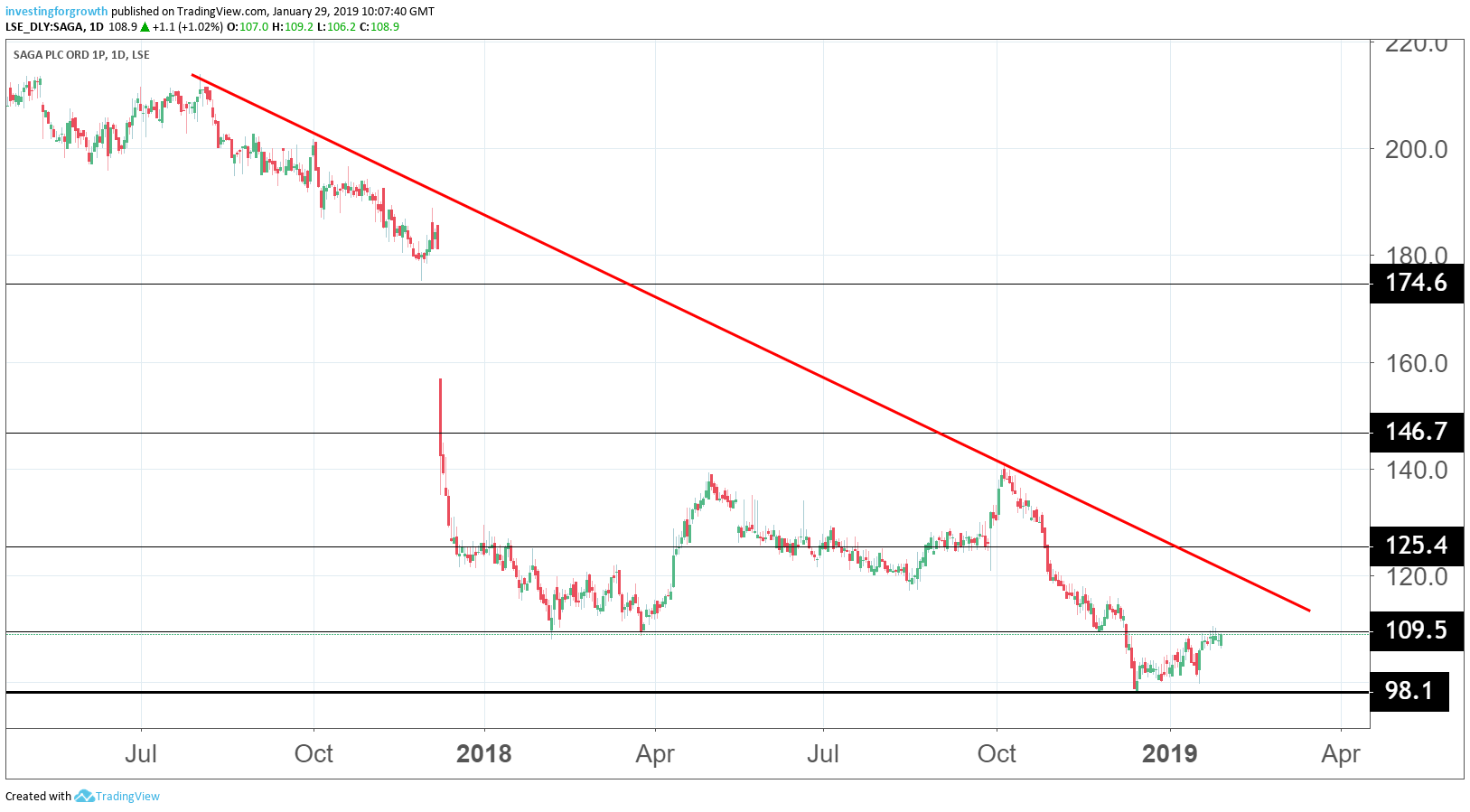Stockwatch: A sustainable 8% dividend yield
29th January 2019 10:45
by Edmond Jackson from interactive investor
Aggressive institutional stake-building underlines the attractiveness of this big yield and low valuation.

Has mid-cap insurer and lifestyle business for the over-50's Saga (LSE:SAGA) finally found support on an 8%-plus yield? And is it being exacted by way of the stock priced rationally for competitive insurance markets, or will it re-rate as the group’s leisure businesses evolve?
Saga was floated at 185p in June 2014 when I wrote to "Avoid" given a likelihood it was over-priced: a mainly insurance stock aiming for a consumer services rating that investors would reject once flotation hype abated.
The stock traded up to 225p in 2015 then dived to about 120p at end-2017/early 2018 as insurance broking hit challenges – mainly in home and travel – and tour operations were hit by the Monarch Airlines administration. The stock de-rated from an average annual historic price/earnings (PE) ratio in the mid-teens (see table) to single figures and a yield over 6%.
Underwriting is the group's best performance area, representing 32% of annual profit versus 27% for home insurance broking, 20% for motor broking and 14% for other insurance. While leisure-travel last represented 50% of annual group income, it was barely 7% of profit.
But after Saga de-rated once again, from about 130p briefly below 100p during the fourth quarter of 2018 downdraft in financial equities, its 8%-plus yield at a current price of 108p looks generous relative to overall risks.

Source: TradingView (*) Past performance is not a guide to future performance
On current information the payout looks likely to be sustained at around 9p with adequate earnings cover around 1.5 times, backed also by strong cash flow. Some £430 million of net debt as of last July should not compromise dividend payouts.
Does 8% yield constitute a prop, where 7% did not?
Results for the year to 31 January 2018 were uninspiring despite meeting guidance, with current year profit guided down some 5% due to investment in growing the customer base.
With the stock at 123p last April, offering a 7.2% yield, I suggested it ought to lend support – which it did for a few months, the price testing 140p by late summer, only to get caught in the stock market plunge that expressly hit financials. Saga shares fell as low as 99p in December before recovering with the market to around 108p currently. The drop more likely related to an exceptional market event than corporate fundamentals.
I remain sceptical of Saga's insurance competitiveness, being a regular target for mailshots to buy their policies: yes, they may be cheaper with a £50 cash-back, though prices will likely hike after the first year.
Last April this kept me from rating the stock a conviction 'buy', though I concluded with 'Accumulate', deciding better to average steadily in, as I thought the yield would start to tempt investors and buy management time to show better results from the travel side as more cruise ships come into operation.
At interim results, the CEO declared: "The business continues to be highly cash generative allowing us to pay a dividend of 3p." Within the CFO's review, conversion of operating profit to cash flow was stated at 67.2%. While that leaves headroom to tweak the final dividend, its annual cost at 9p per share would be £101 million relative to £135 million net cash flow from operations in the last financial year.
Standard Life Aberdeen near trebles its stake to over 14%
Clearly, this investment manager has conviction about Saga’s investment value, regularly increasing its stake from 5.02% last July to over 14% as of 7 January 2019 – committing some £120 million of additional capital to become the largest shareholder.
Implicitly, it believes the dividend payout prospects are secure. The criticism would be Standard Life Aberdeen (LSE:SLA) being the UK's second-largest fund manager after Legal & General (LSE:LGEN), controlling assets towards £700 billion in value, thus needs to keep finding new outlets for cash. Yet a 14% stake of a FTSE 250 company remains a serious commitment it would be tricky and costly to reverse.
Admittedly, there has not been material director buying after this latest drop, where there ought to have been a December window before the 16 January trading update, and currently too before Saga enters its closed period. You can see lots of "Director Shareholding" RNS's albeit in very small lots relating to an incentive plan.
Last April I said watch what extent of equity a new chairman – from 1 May – could buy, which he promptly followed up as 100,000 shares at 128.1p. A respectable commitment, though he should be a man of substance having chaired Old Mutual and previously been CEO of Eagle Star.
| SAGA - financial summary | |||||||
|---|---|---|---|---|---|---|---|
| year ended 31 Jan | Consensus Estimates | ||||||
| 2014 | 2015 | 2016 | 2017 | 2018 | 2019 | 2020 | |
| Turnover (£ million) | 944 | 900 | 963 | 871 | 860 | ||
| IFRS3 pre-tax profit (£m) | 171 | 114 | 176 | 193 | 179 | ||
| Normalised pre-tax profit (£m) | 179 | 138 | 185 | 195 | 181 | 177 | 185 |
| Operating margin (%) | 17.6 | 17.6 | 20.5 | 24.1 | 21.9 | ||
| IFRS3 earnings/share (p) | 11.4 | 8.5 | 13.2 | 14.0 | 14.0 | ||
| Normalised earnings/share (p) | 12.1 | 10.8 | 13.9 | 14.2 | 13.5 | 13.1 | 13.3 |
| Earnings per share growth (%) | -0.6 | -10.8 | 28.1 | 2.0 | -4.5 | -3.4 | 1.8 |
| Price/earnings multiple (x) | 8.0 | 8.3 | 8.2 | ||||
| Historic annual average P/E (x) | 14.2 | 17.8 | 14.9 | 14.0 | 9.7 | 8.2 | |
| Cash flow/share (p) | 15.7 | 15.4 | 13.5 | 12.4 | 12.0 | ||
| Capex/share (p) | 2.6 | 3.0 | 3.9 | 7.4 | |||
| Dividend per share (p) | 7.2 | 8.5 | 9.0 | 9.0 | 9.2 | ||
| Dividend yield (%) | 8.3 | 8.3 | 8.4 | ||||
| Covered by earnings (x) | 1.9 | 1.7 | 1.5 | 1.5 | 1.4 | ||
| Net tangible assets per share (p) | -47.0 | -40.2 | -30.7 | -28.8 | |||
Source: Company REFS Past performance is not a guide to future performance
Middling update for trading since last August
An "in line" update continues a mixed story for insurance with falling home/motor premiums offset by strong underwriting – especially for personal injury claims. It's a tale of two sides in the lifestyle businesses too, with travel revenues flat amid a transfer to higher margin tours serving fewer passengers, while cruise demand is declared "strong".
A marketing scheme offering VIP experiences (though not above offering 40% off main courses at Beefeater) has added some 250,000 members since last September, over one million in all.
Looking back to interims, this business remains small in financial context - "emerging businesses and central costs" up 12.5% to £16.2 million or just 3.8% of group total, its loss reducing 25.3% to £14.5 million. For now, it amounts chiefly to something new to the narrative as Saga attempts ways to cross-sell within its customer database.
"Within emerging businesses is the Saga Magazine which has over 300,000 monthly subscribers. These customers have a significantly higher propensity to buy more than one product from Saga."
Anyway, with the stock around current market values it’s possible to write off growth hopes from the over-50's consumer marketing and regard its price as cheap versus other insurers.
Beats two comparators in the FTSE 100 index
Another insurer weighted towards home and motor, Direct Line (LSE:DLG) yields 6.6% on a forward PE of 11.2 times, assuming current forecasts are right. Aviva (LSE:AV.) is somewhat different, deriving 97% of its last reported operating profit from life insurance, albeit still an insurer and on a forward PE just below 8 times yielding 6.3%.
In raw financial terms, valuation boils down to the dividend and its security. A focus of attention at the 4 April prelims is likely to be operating cash flow: interim to 31 July had cited underlying pre-tax profit 3.7% lower at £107 million, reflecting investment and an "increase in new business acquisition costs in a challenging insurance market".
A 19% rise in motor and home new business was helped by discounting/cash offers for the first year; hardly good from a growth investment view if likely discounted now the yield of 8% or more.
A logical approach is to consider Saga as just one stock in a portfolio of high yielders if income is your objective, spreading risk. A strategy update is promised at the final results, which could also attract recovery investors if well-received. Buy.
*Horizontal lines on charts represent levels of previous technical support and resistance. Trendlines are marked in red.
Edmond Jackson is a freelance contributor and not a direct employee of interactive investor.
These articles are provided for information purposes only. Occasionally, an opinion about whether to buy or sell a specific investment may be provided by third parties. The content is not intended to be a personal recommendation to buy or sell any financial instrument or product, or to adopt any investment strategy as it is not provided based on an assessment of your investing knowledge and experience, your financial situation or your investment objectives. The value of your investments, and the income derived from them, may go down as well as up. You may not get back all the money that you invest. The investments referred to in this article may not be suitable for all investors, and if in doubt, an investor should seek advice from a qualified investment adviser.
Full performance can be found on the company or index summary page on the interactive investor website. Simply click on the company's or index name highlighted in the article.
Disclosure
We use a combination of fundamental and technical analysis in forming our view as to the valuation and prospects of an investment. Where relevant we have set out those particular matters we think are important in the above article, but further detail can be found here.
Please note that our article on this investment should not be considered to be a regular publication.
Details of all recommendations issued by ii during the previous 12-month period can be found here.
ii adheres to a strict code of conduct. Contributors may hold shares or have other interests in companies included in these portfolios, which could create a conflict of interests. Contributors intending to write about any financial instruments in which they have an interest are required to disclose such interest to ii and in the article itself. ii will at all times consider whether such interest impairs the objectivity of the recommendation.
In addition, individuals involved in the production of investment articles are subject to a personal account dealing restriction, which prevents them from placing a transaction in the specified instrument(s) for a period before and for five working days after such publication. This is to avoid personal interests conflicting with the interests of the recipients of those investment articles.